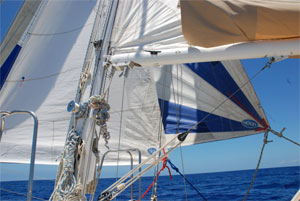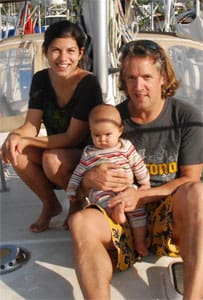You’ve probably seen the CDs on the racks, or heard them in elevators. The general consensus is that the noises of the sea must be gentle, calming and peaceful, which should make them the perfect complement to a good night’s sleep.
Nice idea, but I’ve got news for you: It’s very far from the truth.
CRASH — we roll over onto our portside and the fold-out chart table seat slides out — BANG — the boom tries to lurch back over to starboard but is held by the preventer — SMACK — goes the block of our mainsheet as it wallops onto the roof of the aft cabin — THUMP — as yet more objects slide from their neatly stashed locations and land like icebergs across the floor.
The day-to-day life on an ocean crossing can be many things. It can be exhilarating, a nice consistent sailing wind, breath-taking night skies and the triumph of plotting those positions closer to your goal. There are times when it’s exhausting. But one thing is for sure, it’s supremely unlikely to be quiet.
So far we’ve found that the greatest cacophony occurs during big seas with not quite enough wind to match. These are the conditions in which we generally need to tie a preventer onto the boom, regardless of the point of sail, as the sloppy waves have us plunging from side to side, threatening to back the main. This makes for a pretty noisy state, which is the kind of background racket that puts you continually on edge simply because it sounds so much worse than it really is. When the winds are low, the boom isn’t swinging with great load or force. It still is falling from side to side, however, giving you a rhythmic clatter that stresses your shackles and your nerves. The headsail protests and collapses, noisily flapping all over as you plummet into the trough of the wave, the sheets whack against the steel of the standing rigging, the knot briefly snagging and making the metal twang.
Next come the smacks, the wave that catches you just on the beam or that whips its breaker against your keel or your rudder. The sounds here vary from a loud, sharp slap to a duller, more ominous sounding thud of a blow, which leaves you silently questioning, “Did we just hit something?”
 |
|
A voyaging sailboat is a collection of parts that move, slat, moan, thump and generally make a racket. |
Then there are the creaks, the more subtle moans and groans of the hull, the interior joinery and the floor panels. This is a more melodic but nonstop grumble, like a talkative old relative with an achy hip. You can try dosing various parts of the cabinetry with beeswax or rubbing candles on edges but nothing seems to cure this particular muttering.
At that point you get the screeches and squeaks of the rig and the hum of the mast. There’s a bump, knock, clunk syncopated beat of the autopilot rocking from side to side under the bed. And then add the continual rush and glug of water running along the outside of the hull, and the hiss of the foam as the boat surfs down a wave. A gust of wind brings the slapping of lines against the mast, the vibration of so many different ropes and, for our boat, an almost mournful-sounding, flute-like song that whistles through our A-frame whenever the wind hits 17 knots or more. Then a thunderous rattle and shake of rain on fiberglass signals the latest squall.
Try sleeping through all of that during your downtime. There’s a reason why we only ever resort to using earplugs when we’re at sea.
Some of the sounds that you only ever get hundreds of miles offshore do have a soothing note, however. If the winds are low but steady and the sea is flat, you hear the comforting billowing of canvas as you’re carried gently along by your sails. The far-off sigh of humpback whales or the urgent clicks and squeals of dolphins. Your lines gently purr and they slowly stretch and flex in the soft breeze.
And then comes the strangest sound of all: the silence. The becalmed boat perches noiselessly on a sea where the water becomes a mirror and the horizon is just an abstract notion as the sky and the sea are all one. It is a hush full of anticipation, when you strain your ears in hope of the next breath of wind; that first surge of sound that you long for that will get you sailing again. Because the reality is that we need the noises and all their glorious hullabaloo to keep us going.
Jessica Lloyd-Mostyn and James left England in 2011 aboard Adamastor, a Crossbow 40. Their daughter, Rocket, was born in Mexico and logged her first sea miles on their Pacific crossing in March of 2014. They are currently in New Zealand. Follow their progress at www.water-log.com.

